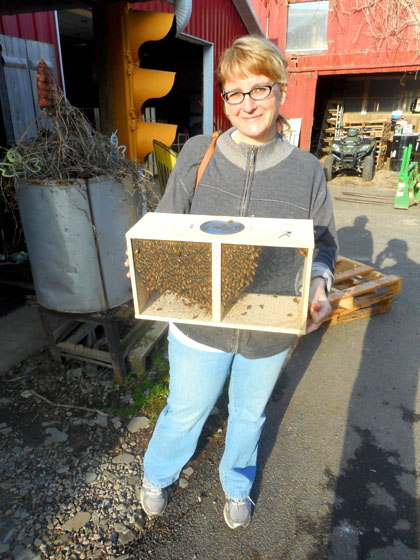
Lady holding our 1st batch of bees.
We are now official beekeepers
Picked up our packet of bees Tuesday morning – 3 pounds of approximately 10,000 bees from California, with one queen bee added at pickup. This is our first batch of bees ever.
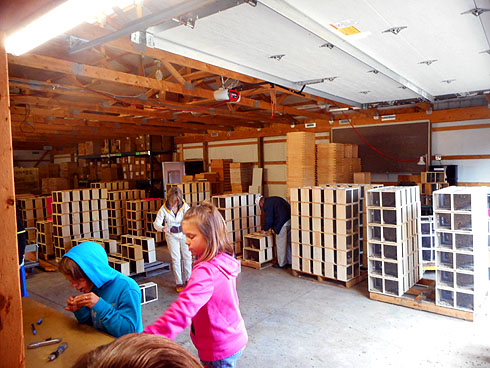
All those stacked boxes are 3 pounds of bees shipped in a trailer truck from California. The young girl in blue is marking queen bees, putting a large blue dot on her back so we can more readily find her when the hive reaches 60-70,000 bees. Need to find the queen or evidence of egg laying to know if you have a healthy hive . . . no healthy queen, no honey money.
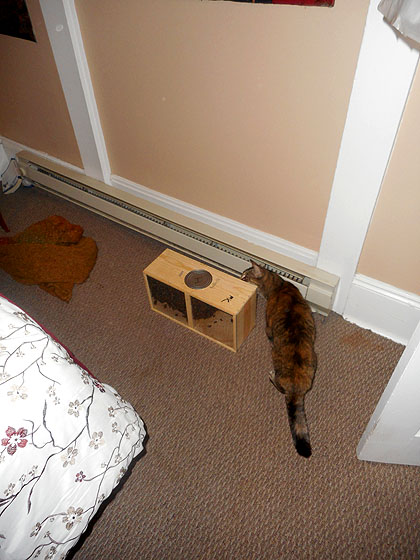
MandyCat checking out the buzz. We sprayed the bees with sugar water and put them in our darkened bedroom for 6 hours until we could drive them out to our hive on her parent’s farm. I lay down on the floor with my face 5 inches from the bees and gently talked to them. At first they were a bit angry, but as I talked telling them what we were going to do and how it would be alright and we would take care of them, they calmed down considerably. The sound from the box was very similar to a high powered electric wire.
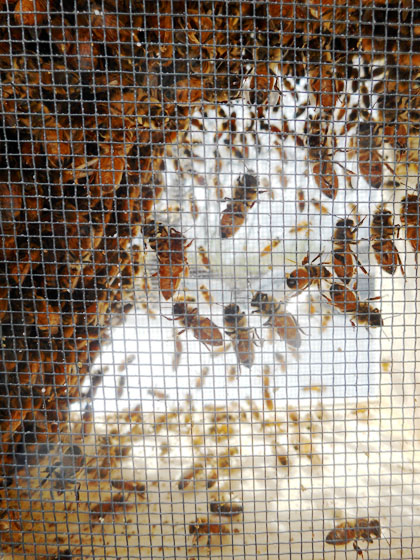
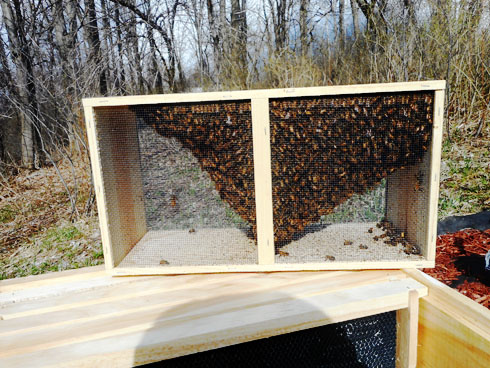
3 pound box of 10,000 bees.
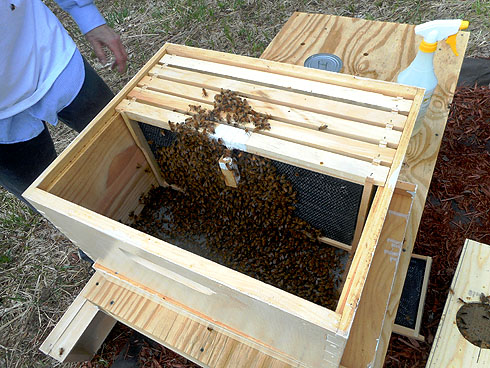
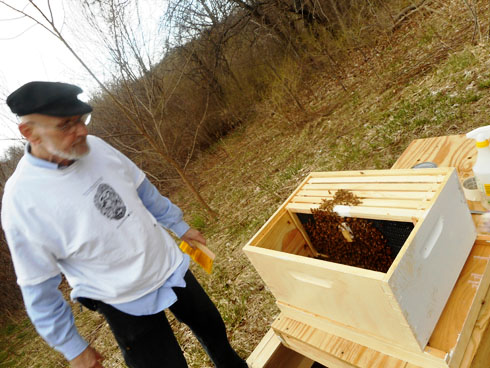
Me dumping bees into hive, fotos by Lady K.
The whitish box at the top of the frame is the queen cage.
I over sprayed the bees with sugar water and had trouble dumping the sticky bees into the hive, so I was violently shaking the bee box back and forth and there was a swarm of bees buzzing angrily around my face, bumping into my head, but none of them stung me. I don’t use a head veil or bee suit or gloves, so I’m quite vulnerable. But I trust the bees, and so far they give my amateurish actions slack. But every beekeeper gets stung, hundreds of times over the years they say, and the venom is supposed to be good for you, helps ease arthritis, get rid of scars, etc. Honey is also an excellent healer for cuts and lacerations and dry itchy skin . . . the Chinese use it extensively.
And just for the record, honey never goes bad. They’ve discovered 5,000 year old honey that is still edible.
One more tidbit – the word honeymoon comes from the old pagan practice of having the newly wed couple drink honey mead for the first month of marriage to ensure their first born is a male, so technically every time you wish someone a happy honeymoon, you are being sexist by encouraging male births.
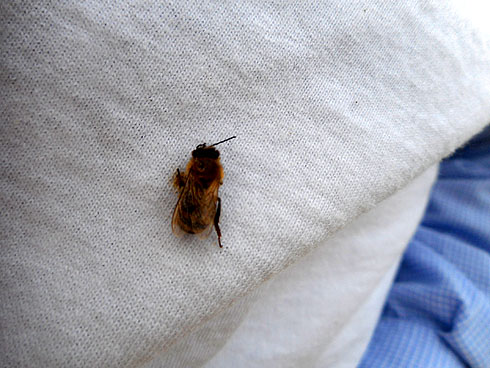
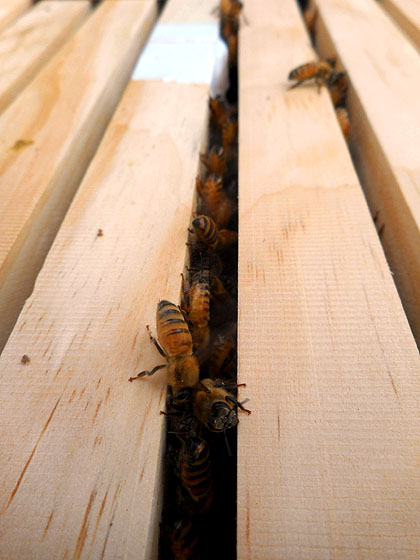
A bee on my shirt. The white patch near the top of the 2nd foto is duct tape we used to hold the queen cage in. The queen is in a wire cage for 3 days because she is new to the hive and they are upset by her pheromones and they want to sting her to death. There’s a hole in the top of the cage stuffed with fondant (or marshmallow in our case) that the bees have to eat through to get to her, but by the time they eat through to her, they should be used to her scent and she’ll crawl out and rule the hive. If they are not used to her, she’s dead, and we’ll have to buy another queen and reseed the colony, losing about a month, which could seriously harm the hive’s chances.
If everything’s okay, she’ll go on a maiden flight with the male drones who will copulate with her in the air, and she’ll spend the next 2 to 3 years laying eggs until she dies or runs down, whereupon we have to buy a new queen and go round again.
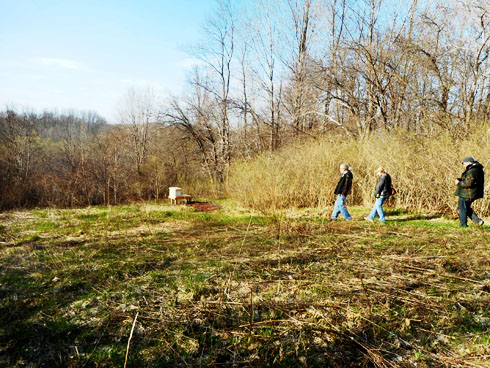
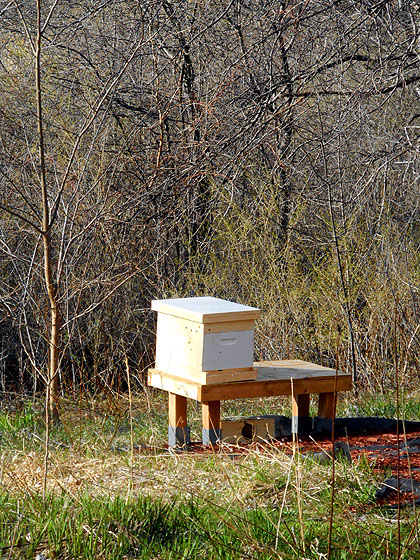
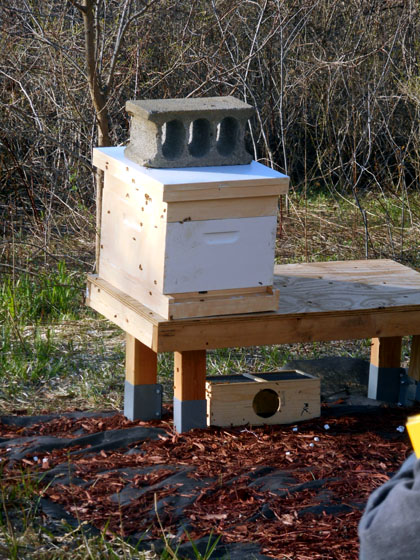
My pa-in-law, wife-in-law, and brother-in-law walking down to check the hive . . . my dog-in-law is just outside the foto.
The most excellent hive stand was designed and built by pa-in-law, a retired engineer.
The box beneath the stand is left open so the sticky bees can lick each other off and fly to the hive above.
We go back out tomorrow to see if our queen is released. If so, we check every 7-10 days until winter because we’re newbie beekeepers and need to learn the signs of a healthy hive. After the first year, you need check only a half-dozen times or so. During the winter you pretty much leave them alone, although you do need to check now and then to see if they’ve enough honey and/or sugar water / pollen patties / grease cakes to get through winter.
As the season progresses, we’ll add 3 more levels to the hive. If they expand more than that, we’ll have to buy a second hive and split them.
A hive can generate 60-90 pounds of honey a year, although usually not the first year. The first year your concern is keeping the hive alive, healthy, and there . . . you may harvest excess honey, you may not.
Right now honey is selling for $8 a pound.
fascinating…. I’m going to happily follow your bee adventure.